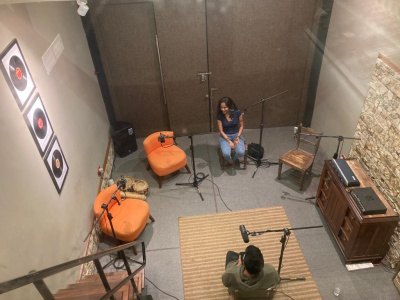Episode 12 of the TIMEZONES podcast series, co-initiated and co-produced by Norient and the Goethe-Institut. This episode explores the creation of art during the political struggle that has shaped Sri Lanka and its capital Colombo since the start of 2022. Sound artist Isuru Kumarasinghe and journalist Devana Senanayake share the perspective of artists and musicians who either lived permanently or temporarily around the Gota Go Gama camp, one of the central sites of the protest.
The Aragalaya Struggle: A Very Brief Introduction
Since the start of 2022, Sri Lanka has been experiencing an economic crisis sparked by a lack of fuel and gas, electricity cuts, skyrocketing prices of food staples, and shortages of medicine. As the conditions worsened, quiet candle-lit vigils rose up around the country and they soon exploded into a series of larger, roadside protests.
In April 2022, a protest outside the president’s house in Mirihana, one of Colombo’s suburbs, led to the arrest of protestors, a declaration of a «state of emergency», and a social media ban. In response, protests proliferated throughout the country.
Protestors had multiple demands but the main one asked for the resignation of the president, Gotabaya Rajapaksa. Chants that included the president’s nickname, Gota, such as «Go Home Gota», could be heard at the protests. People set up a camp that included medical tents, ambulances, food, a library, and an art center – all for free – in Colombo’s oceanside urban park, Galle Face Green. They named this site Gota Go Gama (Gota Go Village). During the protests, several other protest villages popped up in urban areas around the country.
Despite an attack on May 9, 2022 by a pro-state mob, arrest of protestors, and consistent disinformation, protestors achieved many things – the resignation of several Rajapaksa family members from the Cabinet, the resignation of prime minister Mahinda Rajapaksa, and even the resignation of Gotabaya Rajapaksa on July 9. After an early morning attack by police and the army on July 21, protestors received an order to leave Gota Go Gama on August 12. All of them followed this order and vacated the premises.
For further background information around the protests scroll down and check links.
Credits
A podcast by Isuru Kumarasinghe and Devana Senanayake
Co-initiated and co-produced by Norient and the Goethe-Institut
Featuring: King Ratnam, Anu Madhubhashinie, Dinupa Kodagoda, Ajith Kumarasiri, and Namini Panchala
Artistic Editor: Abhishek Matur
Project Management: Hannes Liechti
Video Trailer: Emma Nzioka
Jingle Voiceover: Nana Akosua Hanson
Jingle Mix: Daniel Jakob
Mastering: Adi Flück, Centraldubs
Artwork: Šejma Fere
Photography: Aaqill Nooramith
→ Full transcript of episode 12
Listen on



→ Listen to further TIMEZONES episodes
Featured Artists
King Ratnam is a director, actor, and musician. Currently he helps the Artists of the People’s Movement host marches as part of the people’s protests. Follow him on Twitter.
Anu Madhubhashinie is a vocalist, composer, and dancer. She has been trained in classical and Eastern practices in her music and dance. She was camping on-site at «Gota Go Gama». Follow her on Facebook or YouTube.
Dinupa Kodagoda is a vocalist, dancer, and an actress. She and her husband compose music about social issues related to human relationships and social justice. She has participated in several artists’ marches and contributed to the people’s protests this year. Follow her on Facebook, Instagram, YouTube, or Spotify.
Ajith Kumarasiri has been a key figure in modern alternative music since the 1980s in Sri Lanka. He is committed to issues of social justice and human emancipation. Ajith engages with music in terms of a broader concept of sound as well as noise. Follow him on Youtube or Facebook.
Namini Panchala is a singer-songwriter, composer, and a film music director. She is committed to exploring activism through music, including with regards to women’s rights, animal rights, militarization, and equality. Follow her on Facebook or YouTube.
Bonus Talk
A Deeper Look into the Aragalaya (Struggle)
moderated by Janik Sittampalam, produced by Zainamb Wahid
In this bonus episode, we speak to Devana Senanayake and Isuru Kumarasinghe, the producers of the Colombo TIMEZONES episode on the protest music of the Aragalaya. The economic and political crisis has affected us all here in Sri Lanka, and we talk about living as artists during this tumultuous time. In these past few months, we have witnessed a cultural revolution in addition to the political one, and Devana and Isuru reflect on the process of documenting and capturing the spirit of the protest. We compare this modern movement to the radical movements of Sri Lanka’s past, and how the work we do today might shape how people think of this time in the years to come.
Janik Sittampalam is a writer and journalist based in Colombo, Sri Lanka. He mainly writes about history, culture, and philosophy, seeking the deeper connections lurking beneath the everyday. He also enjoys acting, both on and off stage.
Zainamb Wahid has studied at the SAE (School of Audio Engineering) Institute in Singapore. She has several years of experience as a radio producer and audio engineer, and has been employed in YES 101 and Sri Lanka Broadcasting Corporation (SLBC). She is also a musician in the Symphony Orchestra of Sri Lanka and the Gustav Mahler Society, and conducts violin and piano lessons privately. Follow her on Facebook.
Playlist
Explore a playlist of artists from Colombo and their current releases. A mix of original Sri Lankan popular and underground tracks both by Sinhala and Tamil artists.
Curated by King Ratnam
Trailer
By Emma Nzioka






